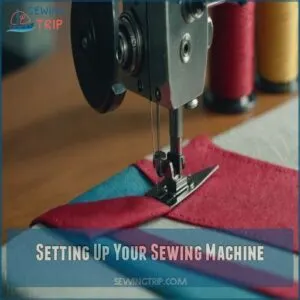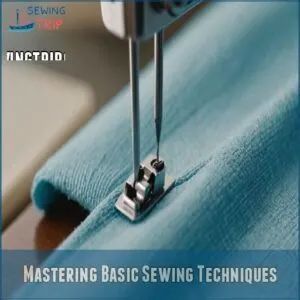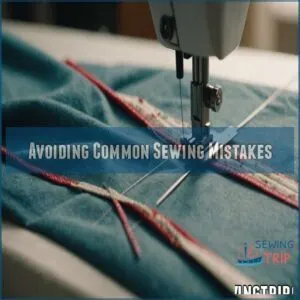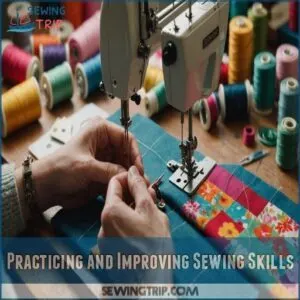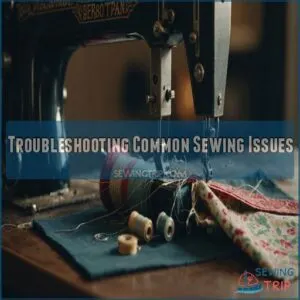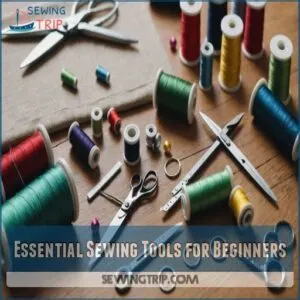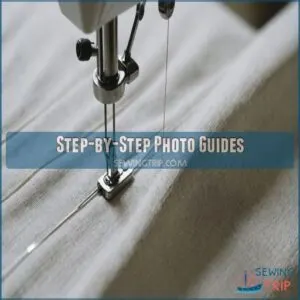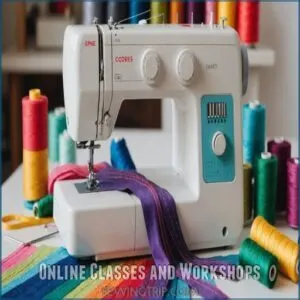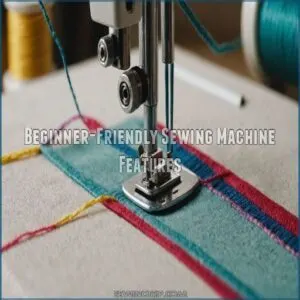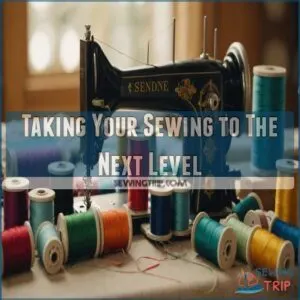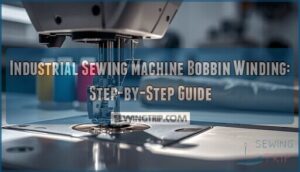This site is supported by our readers. We may earn a commission, at no cost to you, if you purchase through links.
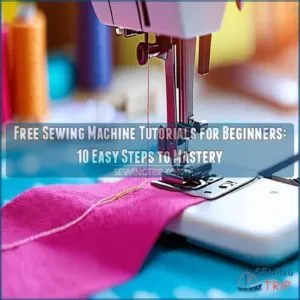 Are you ready to thread your way to sewing success?
Are you ready to thread your way to sewing success?
Free sewing machine tutorials for beginners are just the needle and thread you need to stitch your dreams into reality.
Whether you’re trying to figure out how to avoid sewing over pins—trust me, you want to—or mastering that perfect backstitch, these tutorials are your trusty guide.
Setting up your machine and choosing the right thread isn’t rocket science, but it sure can feel like it.
Having a mentor in these tutorials liberates your inner sewing guru.
Next up, discover secrets to smooth curves and crisp corners that’ll make your projects pop!
Table Of Contents
- Key Takeaways
- Setting Up Your Sewing Machine
- Mastering Basic Sewing Techniques
- Choosing The Right Fabric and Thread
- Avoiding Common Sewing Mistakes
- Practicing and Improving Sewing Skills
- Troubleshooting Common Sewing Issues
- Essential Sewing Tools for Beginners
- Free Sewing Machine Tutorials for Beginners
- Beginner-Friendly Sewing Machine Features
- Taking Your Sewing to The Next Level
- Frequently Asked Questions (FAQs)
- Conclusion
Key Takeaways
- You’ll find free tutorials essential for mastering sewing machine setup, threading, and basic stitches with confidence.
- Use these resources to learn about selecting the right needle and thread for your fabric, ensuring smoother sewing experiences.
- Online classes and communities provide support and guidance, helping you improve quickly through collaborative learning.
- Practice with simple beginner projects, like tote bags and pillowcases, to build foundational skills and gain sewing confidence.
Setting Up Your Sewing Machine
You’re about to begin an exciting sewing journey, and setting up your machine is the first step to stitching success.
Get ready to transform that mysterious contraption into your creative sidekick as we guide you through locating key parts, choosing the right needle and thread, and threading your machine like a pro.
Locating Machine Parts
Before diving in, let’s get acquainted with your sewing machine’s anatomy.
You’ll find the spool pin at the top, where your thread perches like a bird on a wire.
The bobbin winder nearby is your thread’s mini rollercoaster.
Down below, the presser foot holds fabric in place like a gentle giant.
The thread tension guide keeps things running smoothly, while the needle clamp grips your needle tight.
It’s like a miniature city, and you’re the mayor!
Choosing Right Needle and Thread
Now that you’ve got your machine parts down, let’s tackle the dynamic duo: needles and thread.
Think of them as the Batman and Robin of sewing – they’ve got to work together seamlessly.
Your fabric’s the boss here, dictating what needle size and thread type you’ll need.
Here’s a quick cheat sheet to keep you on track:
- Light fabrics: Fine needles (size 9-11) and lightweight thread
- Medium fabrics: Universal needles (size 12-14) and all-purpose thread
- When working with heavy fabrics, consider using a machine with a sturdy metal frame and powerful motor, such as those found in best basic sewing machines. Thick needles (size 16-18) and heavy-duty thread
Threading Machine Correctly
You’ve got your needle and thread ready, so let’s tackle threading like a pro!
Start by winding your bobbin – it’s like filling up your car before a road trip.
Next, follow the thread path, weaving through the tension guide like a nimble acrobat.
Mastering Basic Sewing Techniques
You’re about to discover the secrets of sewing like a pro, so get ready to stitch your way to success!
From mastering the straight stitch to conquering curves,
you’ll soon be creating fabric magic with confidence and flair.
Straight Stitch and Backstitch
Let’s explore the dynamic duo of sewing: straight stitch and backstitch. These stitches are your secret weapons for creating sturdy, professional-looking seams.
Here’s what you need to know:
- Straight stitch: Your go-to for most seams
- Backstitch: Secures thread ends, preventing unraveling
- Adjust stitch length based on fabric type
- Practice on scrap fabric to perfect your technique
- Use these stitches to finish seams and boost stitch quality
Master these, and you’ll be stitching like a pro in no time!
Sewing in a Straight Line
Through the looking glass of your sewing machine, a straight line beckons.
It’s your ticket to pro-level seams!
Keep your fabric taut, eyes on the guide, and hands steady.
Adjust that stitch length to match your fabric’s personality.
Remember, Rome wasn’t built in a day, and neither is perfect stitching.
Practice makes permanent, so keep at it!
| Tip | Why It Matters | How To Do It |
|---|---|---|
| Fabric tension | Prevents puckering | Gently guide, don’t pull |
| Machine guide | Makes sure straight lines | Align fabric edge with guide |
| Hand control | Maintains consistency | Light touch, steady pace |
Turning Corners and Sewing Curves
Ready to take your sewing skills for a spin?
Turning corners and sewing curves can be tricky, but don’t worry – you’ve got this!
Slow down as you approach a curve, easing up on the pedal. Keep your hands steady and guide the fabric gently.
For sharp corners, stop with the needle down, lift the presser foot, and pivot.
Adjust your stitch length for smoother curves – shorter stitches work wonders.
Remember, practice makes perfect, so keep at it!
Choosing The Right Fabric and Thread
You’ll feel like a fabric whisperer once you master the art of choosing the right materials for your sewing projects.
From solid cottons to stretchy knits, you’ll learn to pair fabrics with the perfect thread.
This ensures your creations are both beautiful and durable.
Solid and Elastic Fabrics
You’ll often find yourself torn between solid and elastic fabrics, but don’t sweat it!
Solid fabrics like cotton are your go-to for beginner projects.
They’re stable and easy to handle, especially when using a beginner-friendly sewing machine starter kit, which often comes with basic sewing machine tutorials, perfect for mastering basic sewing techniques.
On the flip side, elastic fabrics like jersey knits offer a bit more challenge but open up a world of comfy, stretchy creations.
Remember, each fabric type has its own personality – treat them right, and they’ll become your trusty sidekicks in your sewing adventures.
Choosing Right Thread for Project
Now that you’ve got your fabric sorted, let’s talk thread.
It’s like finding the perfect dance partner for your fabric.
Match the thread weight to your fabric type – light threads for delicate materials, heavy-duty for denim, and don’t forget to think about the thread’s fiber composition, such as natural threads for breathability.
Color-wise, go for a perfect match or a bold contrast.
Keep an eye on the tension and finish too.
Remember, the right thread can make or break your project!
Pre-washing and Ironing Fabrics
Let’s tackle the fabric prep dance! Pre-washing is your secret weapon against future shrinkage surprises. Toss your fabrics in the wash, matching water temp to care labels. Some fabrics are drama queens, so watch for color bleeding.
Once they’re dry, grab your iron and smooth out those wrinkles. Different fabric types need different ironing techniques, so don’t be shy – give ’em the heat they crave!
Avoiding Common Sewing Mistakes
You’re about to become a sewing superhero, dodging those pesky beginner pitfalls like a pro.
From threading mishaps to pin perils, we’ll show you how to sidestep common sewing blunders and stitch your way to success.
Incorrect Threading and Tension
Thread tension issues can turn your fabric into a battleground.
Ever noticed loopy stitches or puckered fabric?
That’s your machine crying for help!
Uneven stitching and thread breakage are telltale signs of incorrect threading or tension.
Don’t fret, though – mastering this is like learning to ride a bike.
Once you’ve got it, you’ll be zooming through projects with silky-smooth stitches.
Ready to tame that tension beast?
Sewing Over Pins and Not Backstitching
You’ve mastered threading, but watch out for sneaky sewing slip-ups! Sewing over pins is like playing pin-cushion roulette with your machine. It’s tempting, but resist! Remove those pins as you go to avoid needle damage and fabric tears.
And don’t forget to backstitch – it’s your seam’s security guard.
Here’s why these habits matter:
- Prevent needle breakage and potential injury
- Maintain stitch quality and fabric integrity
- Make sure seams don’t unravel, saving you time and frustration
Your sewing journey’s about to get smoother!
Not Using Correct Needle Size
Imagine your sewing machine as a picky eater – it needs the right needle to chew through fabric.
Using the wrong size can lead to a mess of broken needles and wonky stitches.
Match your needle to your fabric type: delicate silks need fine needles, while denim craves a sturdy one.
When in doubt, consult your machine’s manual or a handy needle chart.
Your projects will thank you with smoother sailing and professional-looking results.
Practicing and Improving Sewing Skills
You’re on your way to becoming a sewing pro, and practice makes perfect!
Grab some scrap fabric, fire up those online tutorials, and start stitching simple projects like tote bags or pillowcases – before you know it, you’ll be creating masterpieces faster than you can say "bobbin.
Online Tutorials and Classes
Ready to level up your sewing game?
Online tutorials and classes are your golden ticket.
Check out resources like free sewing tutorials on YouTube and paid courses on platforms like Skillshare and Craftsy for various learning styles and budgets, such as how to learn sewing online.
Before diving into sewing machine tutorials, learn the basics of sewing with helpful guides on how to sew for dummies. Jump into sewing machine tutorials that’ll have you stitching like a pro in no time.
Join online sewing communities to swap tips and tricks with fellow fabric enthusiasts.
Remember, practice makes perfect, so keep at it! You’ll be amazed at how quickly your skills improve.
Simple Projects for Beginners
Diving into simple projects is like dipping your toes in the sewing pool – it’s fun and not too deep!
To get started, you’ll need the right tools, such as a beginner sewing machine, which you can find on websites like Sewing Machine for Beginners.
Let’s kick-start your sewing journey with these beginner-friendly ideas:
- DIY tote bags: Perfect for grocery runs or beach days
- Quilted placemats: Add a personal touch to your dining table
- Easy pillowcases: Spruce up your bedroom in a snap
- Simple scarves: Stay cozy and stylish
These projects will boost your confidence and help you master basic techniques.
Before you know it, you’ll be tackling beginners clothing with ease!
Joining Sewing Community
Camaraderie in sewing can stitch your skills together faster than any machine.
Join online forums to swap tips and troubleshoot hiccups.
Local classes offer hands-on guidance and instant feedback.
Share your projects online—it’s like show-and-tell for grown-ups!
You’ll find inspiration scrolling through others’ creations.
Remember, even seasoned sewers started as beginners.
So don’t be shy, jump into the community.
You’ll be amazed how quickly you’ll level up!
Troubleshooting Common Sewing Issues
You’ve got this!
Even the most seasoned sewists face hiccups, but don’t worry, we’ll tackle those pesky problems together.
From tangled threads to stubborn machines, you’ll soon be troubleshooting like a pro and stitching with confidence.
Thread Breakage and Tangles
Thread tangles got you in knots? Don’t worry, it’s a common hiccup!
Check your thread tension first – it might be too tight or loose.
Make sure you’ve wound your bobbin correctly and chosen the right needle for your fabric type, such as those found in a sewing machine needles set.
High-quality thread can make a world of difference, too.
If you’re still struggling, try rethreading your machine.
Remember, even seasoned sewers face these challenges. You’ve got this!
Machine Jamming and Not Moving
Ugh, your sewing machine‘s acting like a stubborn mule? Don’t sweat it! When your trusty stitcher jams or refuses to budge, it’s often caused by common issues like Thread Issues and Solutions.
Try these quick fixes:
- Check if your bobbin’s threaded correctly
- Make sure your needle isn’t bent or dull
- Clean out any lint or fabric bits
- Double-check your thread tension
Remember, even pros face these hiccups. With a bit of patience and know-how, you’ll have that fabric gliding through smoothly in no time!
Incorrect Stitch Length and Width
Getting the stitch length and width just right can feel like solving a puzzle.
Too short, and your fabric bunches; too long, and the seams loosen quicker than expected.
Adjust tension based on fabric, considering seam allowance.
Think of it as finding harmony between stitch length impact and stitch width effect.
Here’s a quick guide:
| Fabric Type | Stitch Length | Stitch Width |
|---|---|---|
| Cotton | 2.5 mm | 3.0 mm |
| Jersey Knit | 3.0 mm | 4.0 mm |
| Denim | 3.5 mm | 3.5 mm |
Essential Sewing Tools for Beginners
Getting ready to sew is like packing for an adventure; you’ll need the right tools to make the journey smooth and enjoyable.
Grab your rotary cutter, mat, and those trusty accessories, and don’t forget the seam ripper—your friendly companion for any "oops" moments!
Rotary Cutters and Mat
After untangling your latest sewing snafu, you might want a slice of perfection with rotary cutters and mats.
A good mat saves your table, while the cutter slices fabric like butter.
Here’s what to watch out for:
- Rotary cutter safety: Always retract the blade.
- Mat sizes: Choose the right fit.
- Blade types: Keep them sharp.
- Project tips: Test on scraps first.
Sewing Machine Accessories
Your sewing adventure starts with grabbing the essential sewing machine accessories, which are nothing short of your best friends in this creative journey.
Begin with understanding different sewing machine foot types, as having a sharp pair of sewing scissors is also essential for accurately cutting patterns and swatches, including those for choosing the right fabrics; they’re like having different shoes for different tasks!
Don’t forget the foot pedal basics, and make sure to have some sewing machine oil handy.
And always remember, choosing the right needle makes all the difference.
Using a Seam Ripper
A tiny tool, a seam ripper, is your best friend!
Learn seam ripper safety first; gentle, controlled movements prevent accidents.
Different ripper types exist, choose one that fits your hand.
Unpicking seams is easier than you think; use the sharp point to carefully lift stitches.
Fixing mistakes becomes a breeze.
Using a ripper correctly boosts confidence.
Don’t be afraid to experiment!
Free Sewing Machine Tutorials for Beginners
You don’t have to break the bank to become a sewing whiz, thanks to free tutorials that guide you step-by-step with clear photos, online classes, and workshops.
You’ll soon be stitching like a pro, all while avoiding those common "oops, I sewed my finger!" moments.
Step-by-Step Photo Guides
Picture having your spaceship of sewing tools ready, you’ve got the essentials down.
Now, let’s illuminate the path with step-by-step photo guides.
These visual aids are like having a sewing genie whispering in your ear—pinning fabric, threading the machine, and mastering straight stitching and sewing curves.
Each photo speaks a thousand tips, gently leading you through the sewing machine basics without the overwhelming manuals.
You’ll be sewing like a storm, confidently chasing curves like a champion race car driver. Embrace this power, and let the guides make your sewing journey as smooth as silk.
Online Classes and Workshops
Online sewing classes and workshops can be your secret weapon in conquering the sewing world.
Imagine getting the hang of things with grace, all while finding the right instructor who speaks your language.
Engage in workshops that let you explore project ideas, tailoring them to your style.
Here’s the rundown:
- Class Format: Choose a structure that fits your schedule, whether live or on-demand.
- Community Support: Join forums and groups for tips and motivation.
- Hands-on Projects: Practice makes perfect! Hands-on projects boost your confidence and skills.
Get ready to sew like a pro!
Beginner-Friendly Sewing Machine Features
When you’re just starting with sewing, choosing a machine with beginner-friendly features can make your life a lot easier and a lot less tangled.
Look for options like automatic threading and tension, a free arm for tricky sleeves, and built-in stitches and patterns to help spark your creativity as a designer.
Automatic Threading and Tension
Feeling like you’re tangled in threads? Automatic threading benefits you by simplifying setup.
Tension troubleshooting becomes easier, saving time and frustration. It’s like having a sewing pro at your side.
For beginners, investing in a sewing machine for beginners can greatly aid in mastering these features.
Here’s a handy table to guide your sewing journey:
| Feature | Benefit |
|---|---|
| Auto-threading | Quick setup |
| Tension Control | Smooth stitches |
| Bobbin Winding | Efficient use |
| Thread Compatibility | Versatile projects |
| Machine Maintenance | Longevity boost |
With these, mastery’s within reach!
Free Arm and Blind Hemming
When mastering your sewing machine, discovering the free arm feature is like finding an extra pocket in your favorite pants—it’s so handy!
A free arm makes hemming pants and sewing knits much easier.
And blind hemming?
Those tools create nearly invisible seams, perfect for hemming curtains with a pro touch.
You’ll soon be a wizard at crafting those neat, hidden stitches!
Built-in Stitches and Patterns
Your machine’s built-in stitch options are your secret weapon, as they offer a wide variety of stitch patterns, including utility, decorative, and special stitches for different fabrics.
Explore its pattern library; you’ll find a treasure trove of stitch types, from basic straight stitches to decorative stitches.
Many machines boast built-in designs, offering pattern variations to personalize your projects.
Mastering these features is like gaining a new skill – you’ll create unique, impressive pieces.
Don’t be intimidated; experiment and have fun!
Taking Your Sewing to The Next Level
You’re ready to express your creativity by designing your own patterns and experimenting with new sewing styles!
Customizing patterns can be as adventurous as mixing your wardrobe on laundry day, but much more rewarding.
Creating Own Patterns
Drafting your own patterns takes creativity and a few tools to the next level.
Get inspired by clothes you love, then jump into techniques that give you freedom to customize.
Start with simple shapes and let your ideas flow.
With some practice and tips, you’ll discover a new passion for crafting garments that fit perfectly, expressing your unique style with every stitch.
Altering and Customizing Patterns
Got some fabric that doesn’t fit just right?
Let’s tweak those patterns, making them uniquely yours!
By mastering pattern adjustments and sleeve alterations, you’ll add personal flair to each piece.
Whether you’re waist shaping or hemline tweaking, these skills will transform your garments.
Need a change?
Try fabric substitution too.
Grab your tools, put on your creative hat, and start customizing!
Exploring Different Sewing Styles
Imagine diving into the vast world of sewing styles; it’s like exploring a wardrobe with endless surprises.
Experiment with vintage sewing for a timeless touch or try modern sewing trends to stay chic.
To take your sewing to the next level, you need to master key sewing techniques like pressing, staystitching, clipping, seam finishes, hemming, and using a rotary cutter, which are all vital for garment creation basics.
Consider sustainable sewing and upcycling—that’s not just eco-friendly; it’s stylish too!
Tailor clothes for different body types, mastering each stitch, and let creativity transform fabric into art.
Frequently Asked Questions (FAQs)
How do I learn to sew on a sewing machine?
Learning to sew on a machine is like opening up a new skill.
Start with online tutorials, practice threading and stitching simple patterns.
Patience and persistence are key, so embrace mistakes and celebrate small victories as you progress!
What is a good beginner sewing project?
Start sewing with a simple tote bag project.
Mastering your sewing machine is perfect for learning basic stitches and straight sewing lines. When getting started, it’s essential to thread the machine properly. It’s perfect for learning basic stitches and straight sewing lines.
Plus, you get a handy bag at the end!
Remember, it’s the journey, not just the stitches.
How can I make machine sewing easier?
To make machine sewing easier, check your needle and thread pairings, adjust tension correctly, and use high-quality thread.
Keep your workspace tidy, follow your machine’s manual, and remember—practice makes perfect, so don’t get discouraged!
What is a learn to sew course?
Imagine sewing as learning a dance: each step builds skill.
A learn to sew course guides newbies through fabric types, machine basics, and techniques, helping you confidently create your own garments while having fun and avoiding needle pricks!
What is the first thing a beginner should sew?
Start with a simple project!
A pillowcase or tote bag is perfect.
You’ll build confidence, learn basic stitches, and feel that awesome "I made this!" pride.
It’s easier than you think!
Can I teach myself to use a sewing machine?
Picture yourself, needle poised, fabric ready; yes, you can teach yourself to use a sewing machine!
With online tutorials and a sprinkle of patience, you’ll conquer zigzags and straight stitches like a pro.
Sew on!
What is the easiest sewing machine to learn on?
You’re in luck with the Brother CS6000i!
It’s beginner-friendly, jam-packed with features, and won’t break the bank.
You’ll tackle projects in no time with its intuitive controls and handy instructional DVD.
It’s sewing made simple!
How to learn stitching at home for beginners step by step?
To learn stitching at home, gather basic tools like needles, thread, and fabric.
Follow beginner tutorials, practice simple stitches like straight and backstitch, and graduate to using patterns.
Online videos can boost your skills quickly!
How do I maintain my sewing machine?
Keeping your sewing machine in tip-top shape involves cleaning out lint, oiling it regularly, and checking the tension.
Avoid sewing over pins.
Change the needle often.
Always follow the manufacturer’s manual for specific instructions.
Where can I find free sewing patterns?
Imagine opening a treasure chest and finding endless designs.
Discover a world of creativity at sites like Sew Magazine, Mood Fabrics’ Sewciety, and Free Sewing Patterns.
Each offers unique patterns that’ll elevate your sewing projects effortlessly.
What are popular beginner sewing projects?
To start your sewing journey, it’s essential to first master basic sewing machine skills, including adjusting stitch length and width for different fabrics and techniques, as outlined in this Beginner Sewing Guide. Start with beginner sewing projects like tote bags, pillowcases, or simple scarves.
These projects will boost your confidence and skills.
Who knows?
You might even sew a snazzy apron before you can say, "Bobbin!
How to adjust machine for thick fabrics?
For thicker fabrics, you’ll need a heavier-duty needle and slower speed. Adjust your stitch length to be longer, and increase the pressure on your presser foot. You got this!
Which online platforms offer sewing communities?
You’ve got some great spots for sewing communities online!
Try Reddit’s r/sewing for diverse tips,
Facebook Groups for interactive chats, and forums like PatternReview.
It’s like having a fun sewing circle at your fingertips anytime!
Conclusion
Imagine this: sewing’s like piecing together a puzzle—each stitch and pattern fitting perfectly when you’ve got the right guidance.
These free sewing machine tutorials for beginners help you navigate through challenges with ease.
As you practice, remember that every sewing mishap is just another stitch in your journey.
You’ve got access to countless resources, from step-by-step guides to vibrant sewing communities, ready to boost your confidence.
So go ahead, stitch your dreams into reality!

